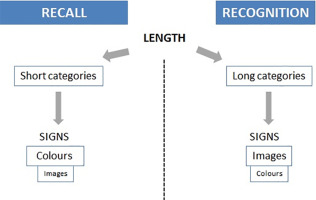Food Research International ( IF 8.1 ) Pub Date : 2018-03-29 , DOI: 10.1016/j.foodres.2018.03.067 Francisco J. Torres-Ruiz , Carla Marano-Marcolini , Esther Lopez-Zafra

|
The present paper focuses on the problems that arise in food classification systems (FCSs), especially when the food product type has different levels or grades of quality. Despite the principal function of these systems being to assist the consumer (to inform, clarify and facilitate choice and purchase), they frequently have the opposite effect. Thus, the main aim of the present research involves providing orientations for the design of effective food classification systems. To address this objective, considering the context of food product consumption (related to heuristic processing), we conducted an experimental study with 720 participants. We analysed the usefulness of heuristic elements by a factorial 2 (category length: short and long) × 3 (visual signs: colours, numbers and images) design in relation to recall and recognition activities. The results showed that the elements used to make the classification more effective for consumers vary depending on whether the user seeks to prioritize the recall or the recognition of product categories. Thus, long categories with images significantly improve recognition, and short categories with colours improve recall. A series of recommendations are provided that can help to enhance FCSs and to make them more intuitive and easier to understand for consumers. Implications with regard to theory and practice are discussed.
中文翻译:

寻找以消费者为中心的食品分类系统。一种实验性启发式方法来区分质量等级
本文着重于食品分类系统(FCS)中出现的问题,尤其是当食品类型具有不同级别或质量等级时。尽管这些系统的主要功能是协助消费者(告知,澄清和促进选择和购买),但它们通常会产生相反的效果。因此,本研究的主要目的涉及为有效食品分类系统的设计提供方向。为了实现这一目标,考虑到食品消费的背景(与启发式加工有关),我们对720名参与者进行了一项实验研究。我们通过因子2(类别长度:短和长)×3(视觉符号:颜色,数字和图像)设计来分析启发式元素在回忆和识别活动方面的有用性。结果表明,使分类对消费者更有效的要素取决于用户是否希望优先考虑召回或识别产品类别。因此,带有图像的长类别可以显着提高识别度,而带有颜色的短类别可以改善召回率。提供了一系列建议,这些建议可以帮助增强FCS并使它们对于消费者而言更加直观和易于理解。讨论了有关理论和实践的含义。提供了一系列建议,这些建议可以帮助增强FCS并使它们对于消费者而言更加直观和易于理解。讨论了有关理论和实践的含义。提供了一系列建议,这些建议可以帮助增强FCS并使它们对于消费者而言更加直观和易于理解。讨论了有关理论和实践的含义。


























 京公网安备 11010802027423号
京公网安备 11010802027423号